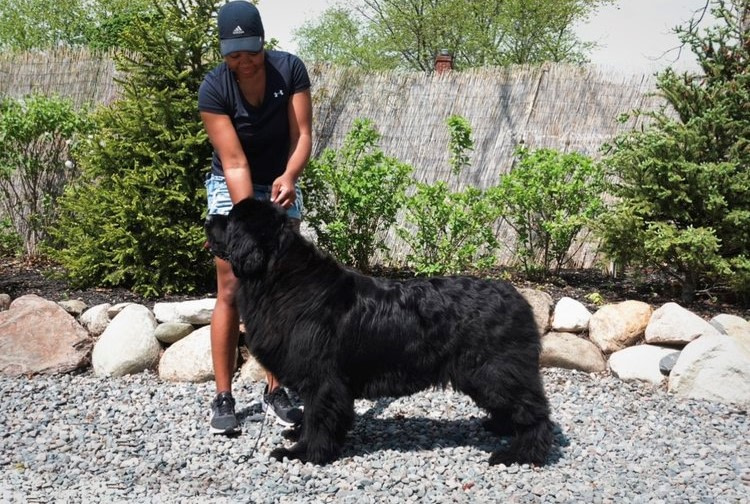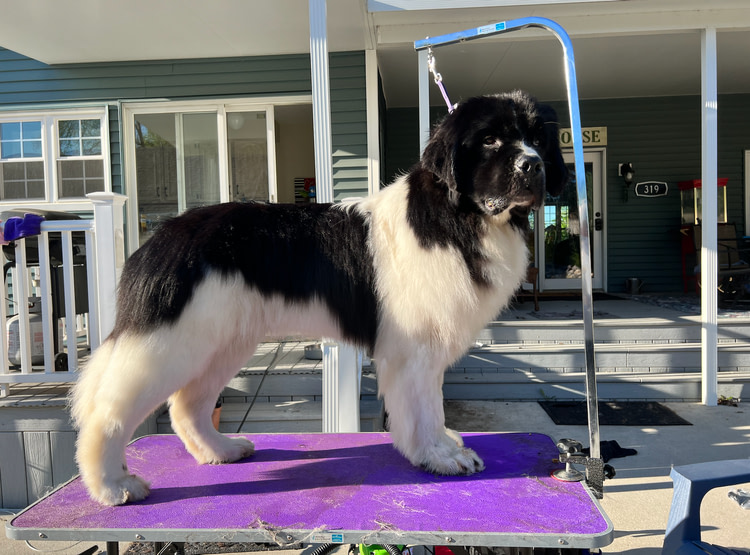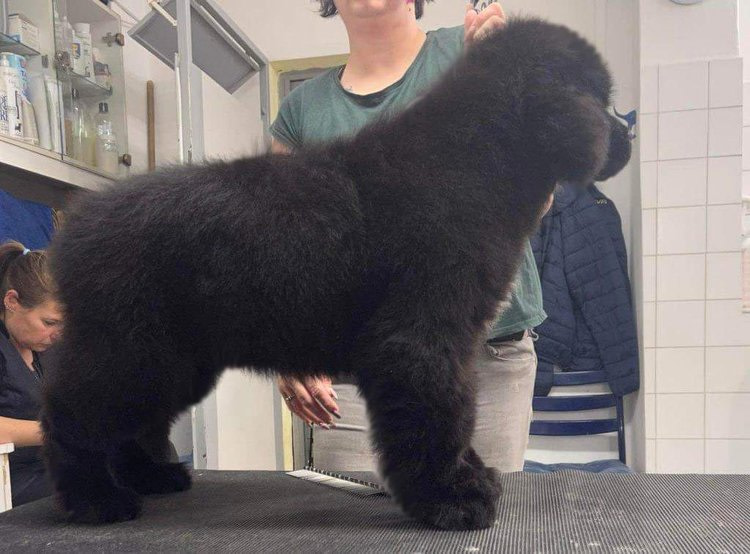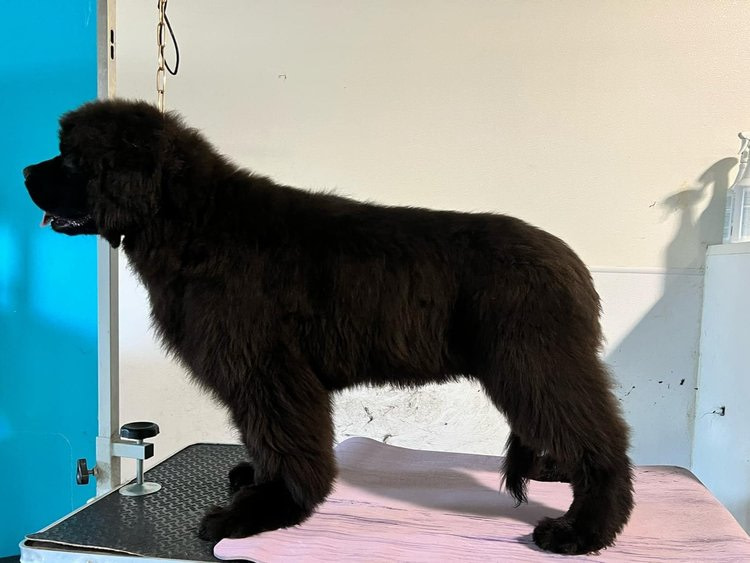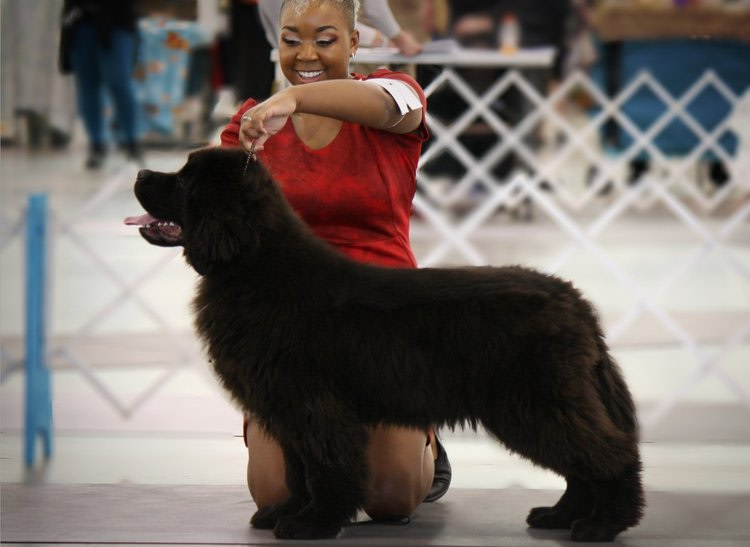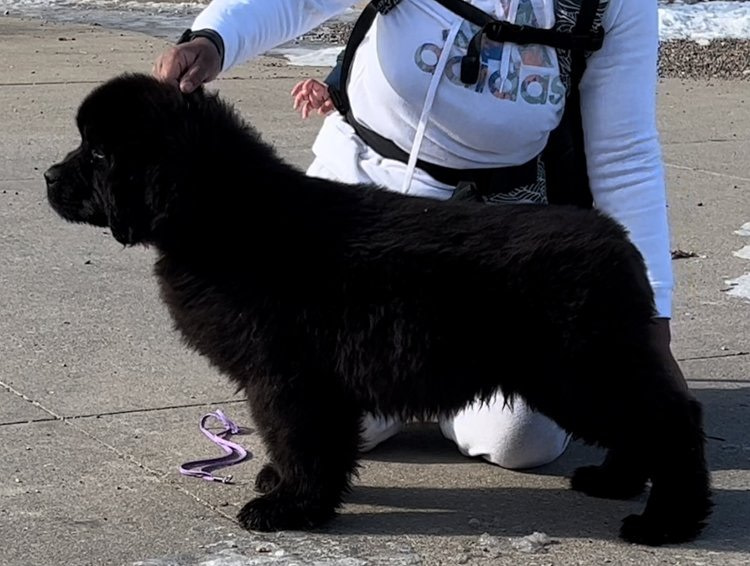Our Newfoundlands in Iowa City
Our Newfoundlands are ethically bred and we pride ourselves on ensuring that they are up to the standards and qualifications of the American Kennel Club Standard—our dogs are the best of the best.
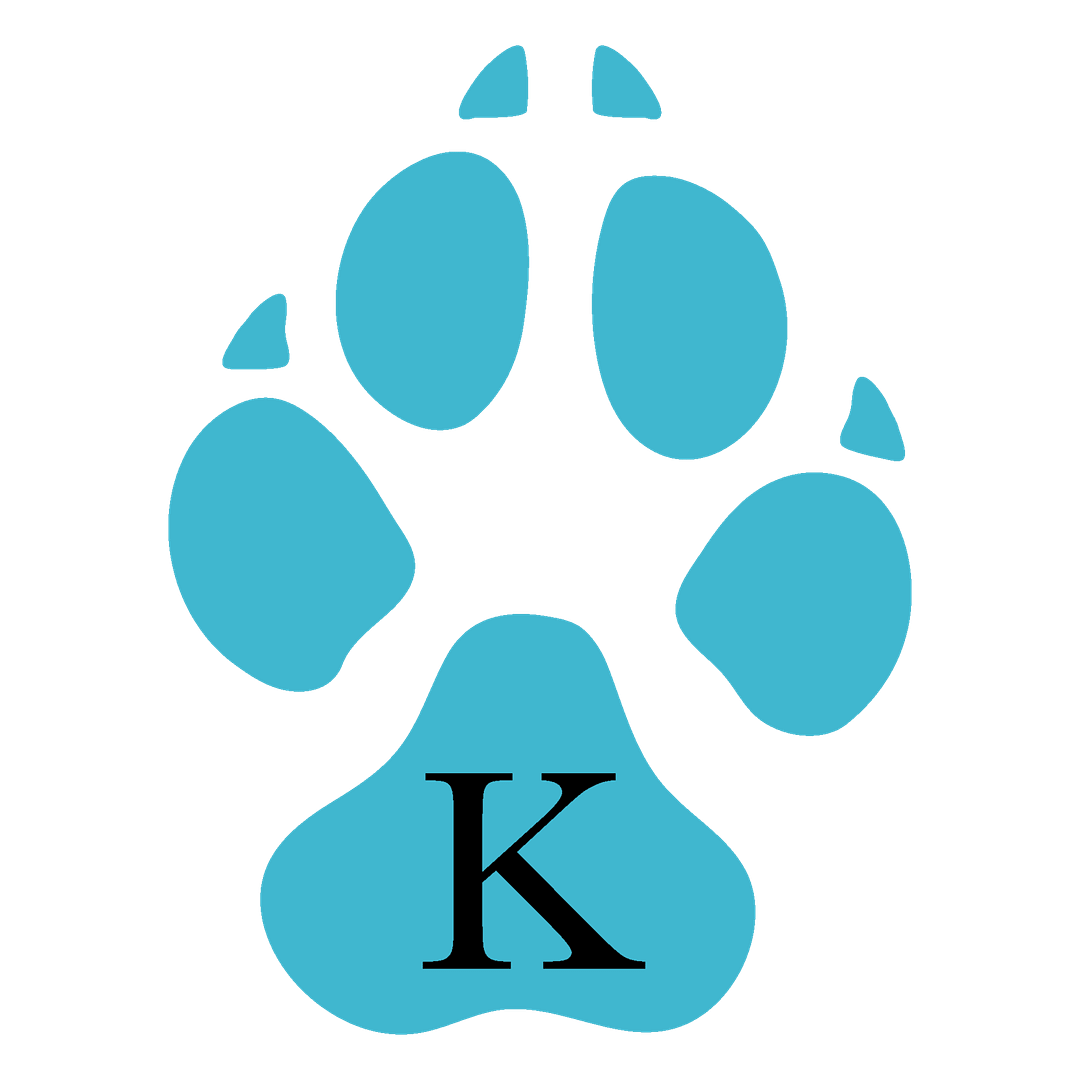
About Newfoundland Breeding in the Heart of Iowa City
Newfoundlands are known for their fluffy and large appearance. With colors extending to black, brown, grey, or white, they are gorgeous dogs that are sweet-tempered and gentle giants.
Learn About The Newfoundland Standard
To find standard information on general appearance, neck, topline, body, forequarters, hindquarters, size, proportion, substance, head, coat, color, gait, and temperament of the Newfoundland click the button below.
Note: These documents are not my original work. Photos are not of our dogs. Content comes directly from The American Kennel Club, The Newfoundland Club of America, and The Newfoundland (by Emmy Bruno). Image owners listed under each photo.
The Newfoundland Standard
Characteristics Of The
Standard
Newfoundland
American Kennel Club's Newfoundland Breed Standard and Importance of Reputable Breeding Practices
With the Newfoundland breed rising in popularity, backyard breeders have rose along with it. I often hear puppy buyers say “I don’t plan on showing so I don’t need a dog from showlines” and “the standard doesn’t matter for a family dog”.
Both of these statements are false.
Form Follows Function. Purebred does not mean Well-bred. Health Tests are not a simple vet visit.
The American Kennel Club has a standard for each purebred breed to ensure that there is consistency and predictability in the breed when it comes to structure, movement and temperament. Any breeder breeding against these set of standards is not reputable. Breeders that breed for fad colors, size, and fails to have OFA Hips, Elbows and Cardiac, as well as Cystinuria tests done on their breeding dogs is not reputable. Any breeder breeding a male or female before the age of two is not reputable. Reputable breeders do not have accidental litters. Use this checklist when screening breeders (checklist source: newfpuppy.com).
Even if you are not wanting a Newfoundland to show, you will want a family dog that will have a life of being healthy and active. Newfoundlands are a giant breed and having correct structure is of upmost importance. Breeders that focus on producing puppies that adhere to the standard and are capable of being shown are the very best option you can get for a family dog. These dogs should live long, happy and healthy lives. They will have predictable temperament, movement and health.
The AKC is the keeper of an individual dog’s records and well as the keeper of a breed’s written standard. Breed standards are created by the respective breed’s parent club. In this case, the NCA. (Newfoundland Club of America).
All photos provided are of great examples of the breed from reputable breeders and professional handlers for learning purposes we have no connect or affiliation with them.
General Appearance
The Newfoundland is a sweet-dispositioned dog that acts neither dull nor ill-tempered. He is a devoted companion. A multipurpose dog, at home on land and in water, the Newfoundland is capable of draft work and possesses natural lifesaving abilities. The Newfoundland is a large, heavily coated, well balanced dog that is deep-bodied, heavily boned, muscular, and strong. A good specimen of the breed has dignity and proud head carriage.
Note: The following description is that of the ideal Newfoundland. Any deviation from this ideal is to be penalized to the extent of the deviation. Structural and movement faults common to all working dogs are as undesirable in the Newfoundland as in any other breed, even though they are not specifically mentioned herein.
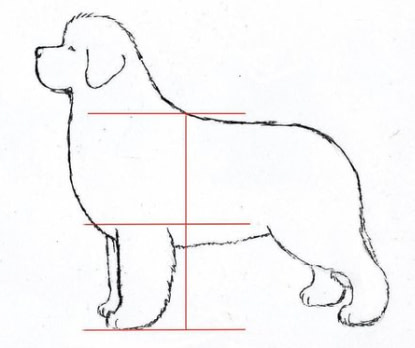
Correct proportion withers to elbow and elbow to the ground – 50%:50% of height in withers. If the dog has correct deep chest and some coat on it, it can give appearances to be a bit short in legs even if it’s not.
Source: Bruno, Emily The Newfoundland. Doral Pub., 1997.

Owner Image:
Source: Westminsterkennelclub.org. 2022. Newfoundland. [online] Available at: <https://www.westminsterkennelclub.org/breeds/newfoundland> [Accessed 14 March 2022].
Size, Proportion, Substance
The average height for adult dogs is 28 inches, while for adult females it is 26 inches. Approximate weight of adult dogs range from 130 to 150 pounds, adult females from 100 to 120 pounds. The dog’s appearance is more massive throughout than the bitch’s. Large size is desirable, but never at the expense of balance, structure, and correct gait.
The Newfoundland is slightly longer than tall when measured from the point of shoulder to point of buttocks and from withers to ground. He is a dog of considerable substance which is determined by spring of rib, strong muscle, and heavy bone.
Source: Official Standard of the Newfoundland, American Kennel Club, 8 May 1980.
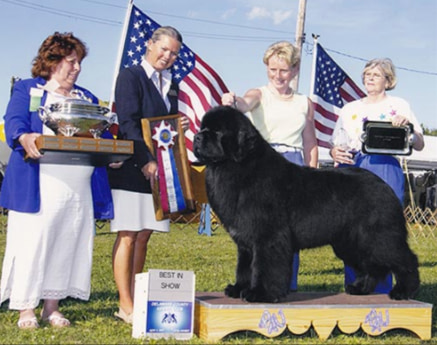
Owner of Image: Pouchcove Kennels – BIS, BISS Ch. Darbydale’s All Rise Pouch Cove, ROM, “Josh”
Head
The head is massive, with a broad skull, slightly arched crown, and strongly developed occipital bone. Cheeks are well developed. Eyes are dark brown. (Browns and Grays may have lighter eyes and should be penalized only to the extent that color affects expression.) They are relatively small, deep-set, and spaced wide apart. Eyelids fit closely with no inversion.
Ears are relatively small and triangular with rounded tips. They are set on the skull level with, or slightly above, the brow and lie close to the head. When the ear is brought forward, it reaches to the inner corner of the eye on the same side.
The expression is soft and reflects the characteristics of the breed: benevolence, intelligence, and dignity. Forehead and face are smooth and free of wrinkles. Slope of the stop is moderate but, because of the well developed brow, it may appear abrupt in profile. The muzzle is clean-cut, broad throughout its length, and deep. Depth and length are approximately equal, the length from tip of nose to stop being less than that from stop to occiput. The top of the muzzle is rounded, and the bridge, in profile, is straight or only slightly arched. Teeth meet in a scissors or level bite. Dropped lower incisors, in an otherwise normal bite, are not indicative of a skeletal malocclusion and should be considered only a minor deviation.
Source: Official Standard of the Newfoundland, American Kennel Club, 8 May 1980, https://images.akc.org/pdf/breeds/standards/Newfoundland.pdf.
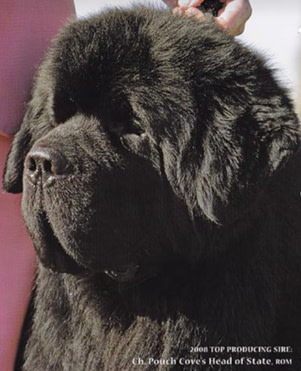
Owner of Image: Pouchcove Kennels – Ch Pouchcove Head of State
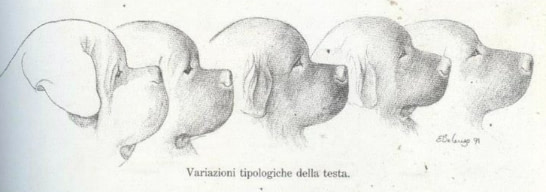
Variability of head types from book of Emmy Bruno. The middle one should be the most correct and second and forth from the left can be accepted. The first and the last are out of type. Today, the head preferred by many is the head second from the left.
Neck, Topline, Body
The neck is strong and well set on the shoulders and is long enough for proud head carriage. The back is strong, broad, and muscular and is level from just behind the withers to the croup. The chest is full and deep with the brisket reaching at least down to the elbows. Ribs are well sprung, with the anterior third of the rib cage tapered to allow elbow clearance.
The flank is deep. The croup is broad and slopes slightly. Tail set follows the natural line of the croup. The tail is broad at the base and strong. It has no kinks, and the distal bone reaches to the hock. When the dog is standing relaxed, its tail hangs straight or with a slight curve at the end. When the dog is in motion or excited, the tail is carried out, but it does not curl over the back.
Source: Official Standard of the Newfoundland, American Kennel Club, 8 May 1980, https://images.akc.org/pdf/breeds/standards/Newfoundland.pdf.
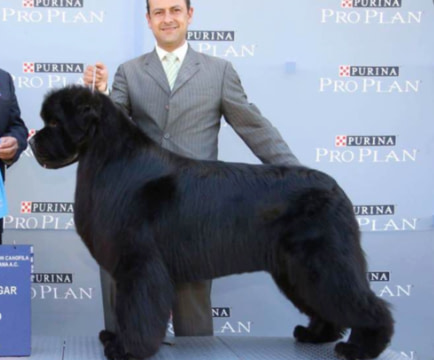
Owner of Image: Lux Jimenez – Tender Ebony Kennels – MBIS MCH Beauty Mark Tender Ebony
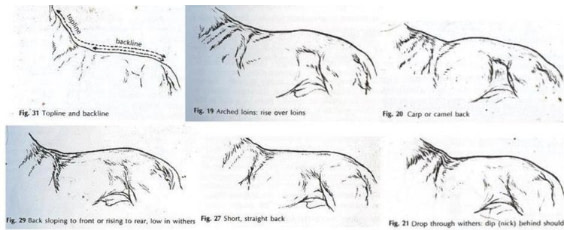
Backline 1
Fig 37 is the correct backline (also known as topline) for a Newfoundland.
Forequarters
Shoulders are muscular and well laid back. Elbows lie directly below the highest point of the withers. Forelegs are muscular, heavily boned, straight, and parallel to each other, and the elbows point directly to the rear. The distance from elbow to ground equals about half the dog’s height. Pasterns are strong and slightly sloping. Feet are proportionate to the body in size, webbed, and cat foot in type. Dewclaws may be removed.
Hindquarters
The rear assembly is powerful, muscular, and heavily boned. Viewed from the rear, the legs are straight and parallel. Viewed from the side, the thighs are broad and fairly long. Stifles and hocks are well bent and the line from hock to ground is perpendicular. Hocks are well let down. Hind feet are similar to the front feet. Dewclaws should be removed.
Source: Official Standard of the Newfoundland, American Kennel Club, 8 May 1980, https://images.akc.org/pdf/breeds/standards/Newfoundland.pdf.
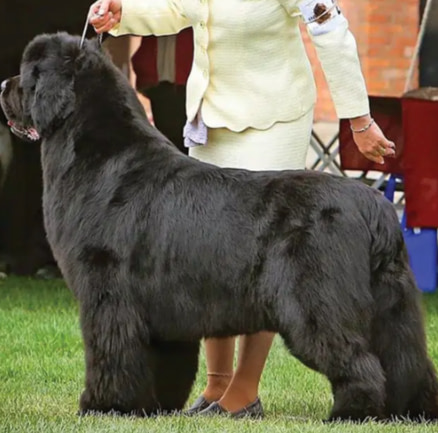
Owner of Image:
Source: Showsightmagazine.com. 2022. Judging The Newfoundland Is Is All About The Balance – Showsight. [online] Available at: <https://showsightmagazine.com/judging-the-newfoundland-it-is-all-about-the-balance/> [Accessed 14 March 2022].
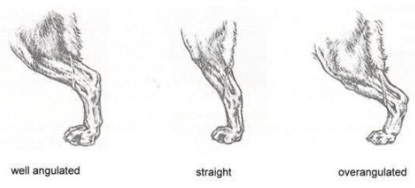
Rear Pasterns Angulations
Source: Bruno, Emmy. The Newfoundland. Doral Pub., 1997.
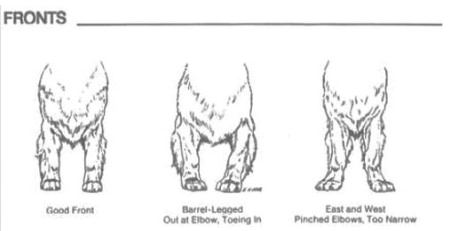
Source: Bruno, Emmy. The Newfoundland. Doral Pub., 1997.
Coat
The adult Newfoundland has a flat, water-resistant, double coat that tends to fall back into place when rubbed against the nap. The outer coat is coarse, moderately long, and full, either straight or with a wave. The undercoat is soft and dense, although it is often less dense during the summer months or in warmer climates.
Hair on the face and muzzle is short and fine. The backs of the legs are feathered all the way down. The tail is covered with long dense hair. Excess hair may be trimmed for neatness. Whiskers need not be trimmed.
Source: Official Standard of the Newfoundland, American Kennel Club, 8 May 1980, https://images.akc.org/pdf/breeds/standards/Newfoundland.pdf.
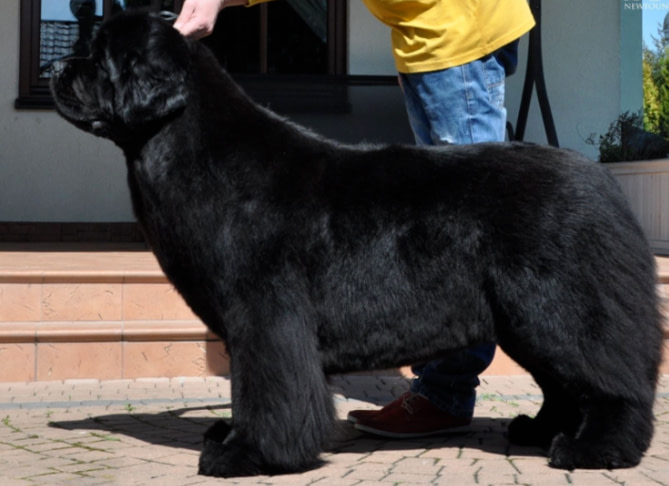
Owner of Image: Piotr Pasek – Disoranto Kennels – Registered Name Unknown
Color
Color is secondary to type, structure, and soundness. Recognized Newfoundland colors are black, brown, gray, and white and black.
Solid Colors: Blacks, Browns, and Grays may appear as solid colors or solid colors with white at any, some, or all, of the following locations: chin, chest, toes, and tip of tail. Any amount of white found at these locations is typical and is not penalized. Also typical are a tinge of bronze on a black or gray coat and lighter furnishings on a brown or gray coat.
Landseer: White base coat with black markings.
Typically, the head is solid black, or black with white on the muzzle, with or without a blaze. There is a separate black saddle and black on the rump extending onto a white tail. Markings, on either Solid Colors or Landseers, might deviate considerably from those described and should be penalized only to the extent of the deviation. Clear white or white with minimal ticking is preferred. Beauty of markings should be considered only when comparing dogs of otherwise comparable quality and never at the expense of type, structure and soundness.
Disqualifications – Any colors or combinations of colors not specifically described are disqualified.
Source: Official Standard of the Newfoundland, American Kennel Club, 8 May 1980, https://images.akc.org/pdf/breeds/standards/Newfoundland.pdf.
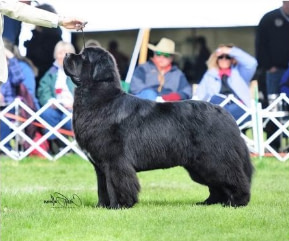
Black
Owner of Image: Marci S – Sundust Newfoundlands – Ch Daybreakers Writings on The Wall
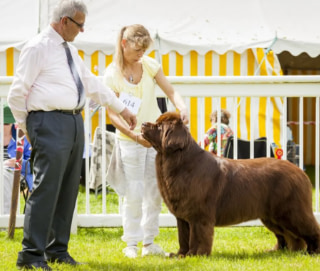
Brown
Owner of Image: Terri Lewin
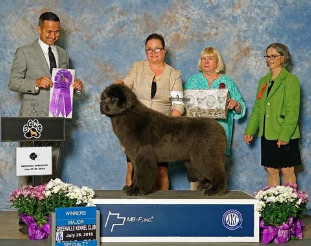
Gray
Owner of Image: Julie Fitser – Kennel Name Unknown – Registered Name Unknown

Landseer
Owner of Image: Kseniya Novikova – Akvian Song – Akvian Song Cafira
Gait
The Newfoundland in motion has good reach, strong drive, and gives the impression of effortless power. His gait is smooth and rhythmic, covering the maximum amount of ground with the minimum number of steps. Forelegs and hind legs travel straight forward. As the dog’s speed increases, the legs tend toward single tracking.
When moving, a slight roll of the skin is characteristic of the breed. Essential to good movement is the balance of correct front and rear assemblies.
Source: Official Standard of the Newfoundland, American Kennel Club, 8 May 1980, https://images.akc.org/pdf/breeds/standards/Newfoundland.pdf.
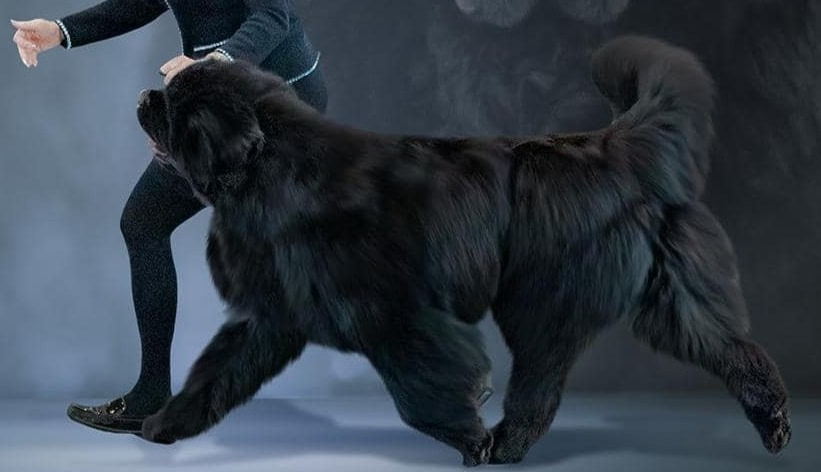
Owner of Image: Christina Heard – Summerford Newfoundlands – BIS CAN CH / AM CH / RO JCH MIDNIGHT LADY’S RUMBLE IN THE JUNGLE (ZOMBIE)
Temperament
Sweetness of temperament is the hallmark of the Newfoundland; this is the most important single characteristic of the breed.
Source: Official Standard of the Newfoundland, American Kennel Club, 8 May 1980, https://images.akc.org/pdf/breeds/standards/Newfoundland.pdf.
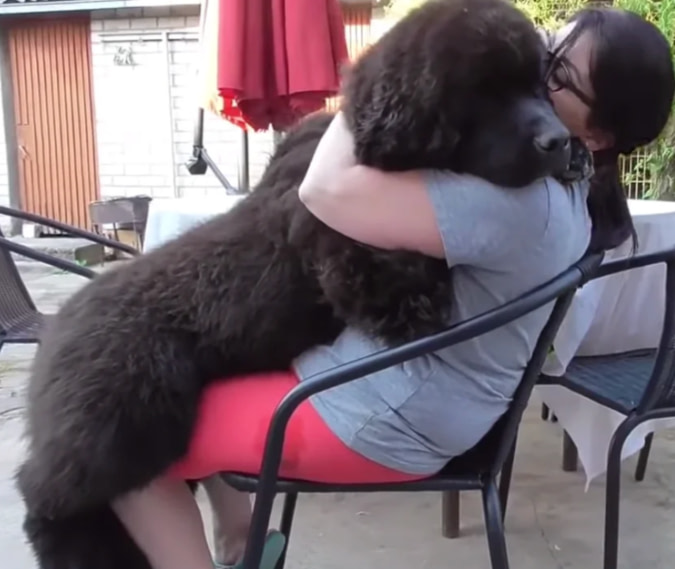
Dispelling Myths About Newfoundlands
Have more questions? Get in touch today to learn more and get your questions answered.For the source of this information click here.
Granted, these colors are genetic, but these colors do not follow the AKC Newfoundland Breed Standards set forth by the parent club, the Newfoundland Club of America.
The Newfoundland Standard states that while a large size is desirable it is never to be at the expense of structure and soundness.
Newfoundlands have a deep muzzle which can make them prone to drooling. A reputable breeder cannot guarantee that a Newfoundland will not drool.
It is impossible to determine the health of a god unless you look inside!
NOT TRUE!!!! A dog’s front end carries most of the weight. It’s the first thing that hits the ground when a dog jumps.
This does not guarantee good quality. Dogs may get first place ribbons at practice sessions or at a dog show where there is only one dog entered. A breeder needs to participate in dog shows on a regular basis. This is how they prove their dogs are excellent conformation (structural) quality.
Reputable breeders DO NOT allow this to happen.
Making money breeding dogs is a contradiction in terms. A routine cesarean section can cost $2,000. Routine puppy shots, food and laundry costs will eat up any potential profit. Most breeders work to support their dogs.
Genetics doesn’t work this way. If it did children would all look the same. Your chances of getting a dog identical to your first is impossible.
Several champions out of 30 dogs in 4 generations does not constitute championship lines. Championship lines means that nearly all of the 30 dogs in the 4 generations are champions. This demonstrates a commitment to breeding dogs of excellent quality and health.
A fun and experienced dog trainer in Iowa City
We are ready to start your dog’s journey to being the best dog they can be.















